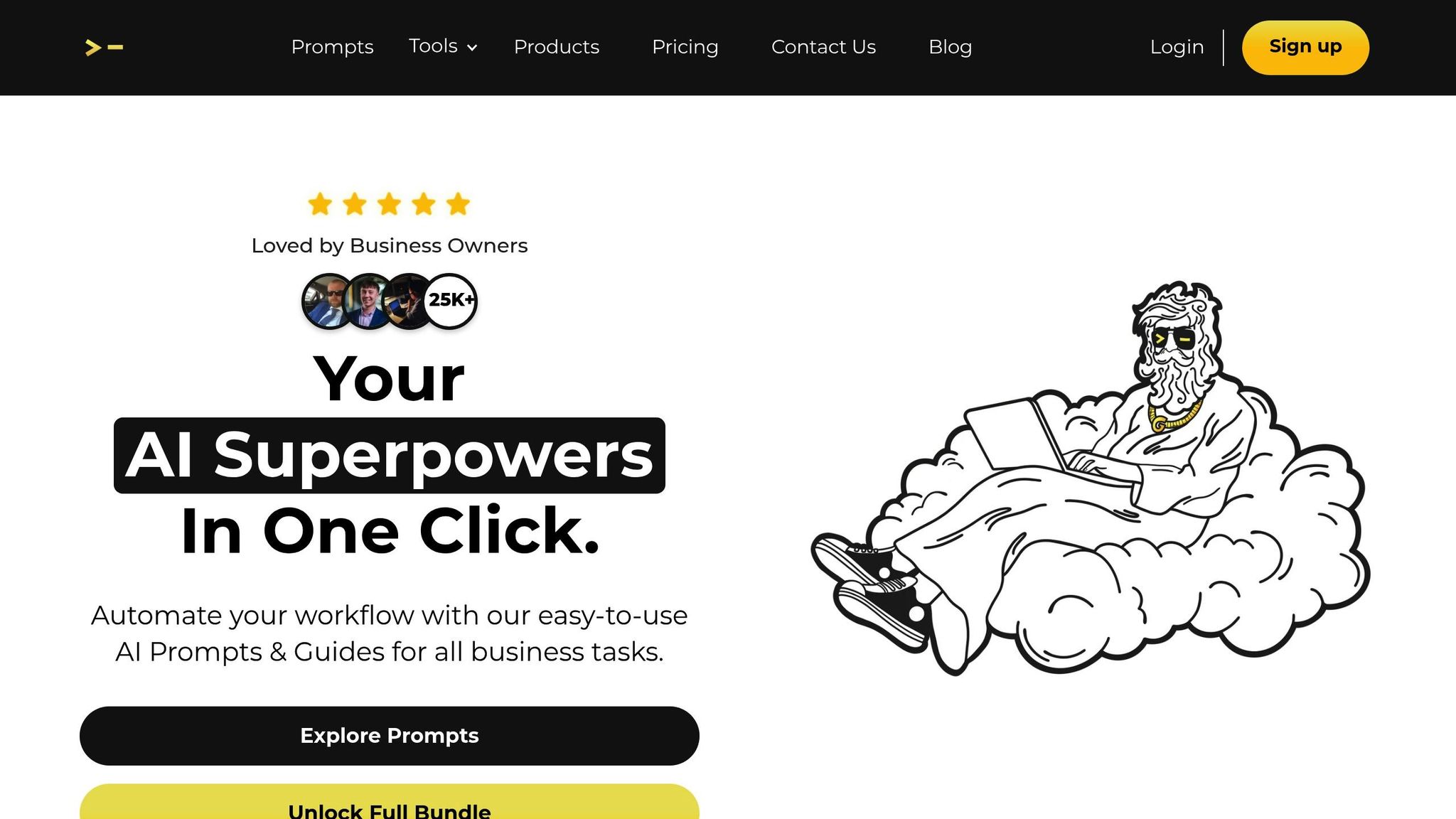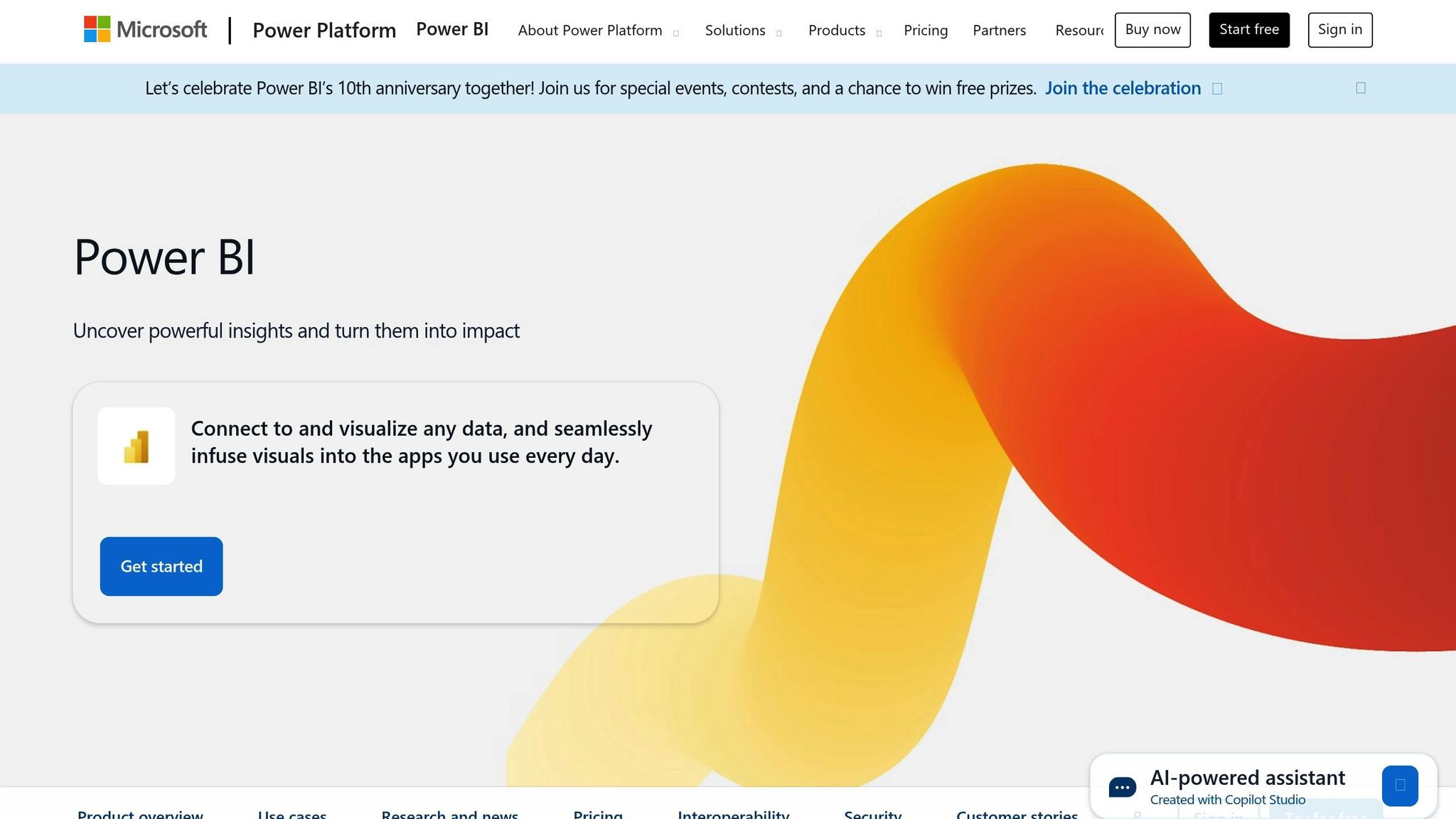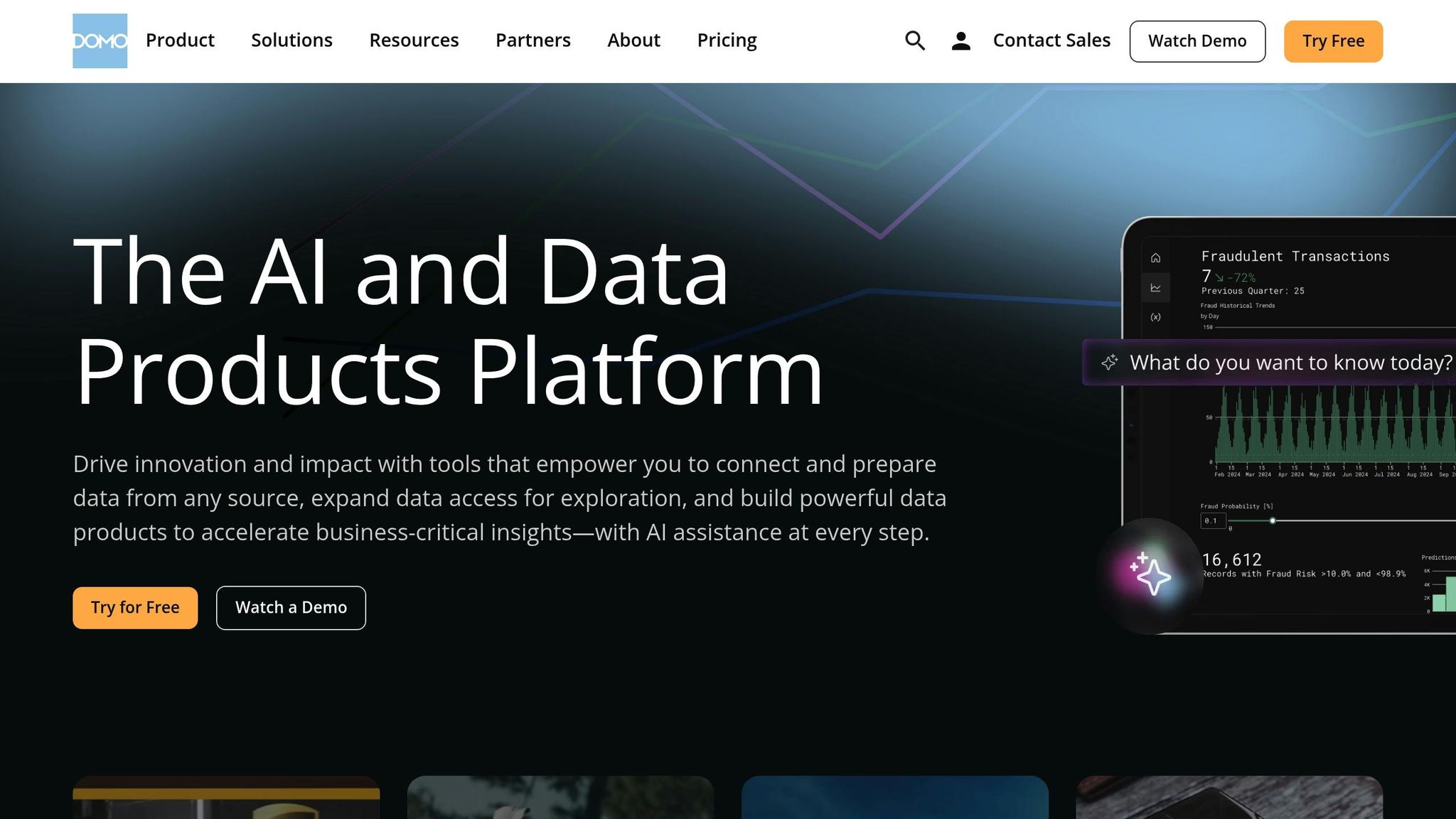
In a world where businesses are drowning in data, AI-powered visualization tools are turning raw information into actionable insights. These tools go beyond static charts, offering dynamic, predictive analytics that help businesses make faster, smarter decisions. With the data visualization market projected to reach $18.36 billion by 2030, companies are increasingly relying on AI to uncover trends, automate analysis, and create interactive dashboards.
Here are 8 AI tools transforming data visualization:
| Tool | Key AI Features | Integration Options | Pricing (USD) | Best For |
|---|---|---|---|---|
| God of Prompt | AI prompts for ChatGPT, Midjourney | ChatGPT, Claude, Gemini AI | Free – $150 (one-time) | AI-driven data workflows |
| Tableau | Predictive analytics, Tableau Pulse | Salesforce, SAP, Excel | $15–$70/month per user | Design-focused teams |
| Power BI | Copilot, anomaly detection | Microsoft ecosystem | $14–$8,409.60/month | Microsoft-centric setups |
| Looker | Predictive analytics, anomaly tools | Google Cloud native | $35,000+/year | Large enterprises |
| Qlik Sense | GenAI, real-time updates | Cloud and on-premise | $825–$2,500+/month | Mid to large businesses |
| Sisense | Generative AI, embedded analytics | 100+ native connectors | $3,000+/month | Complex data environments |
| Domo | AI Chat, predictive analytics | Snowflake, AWS, Databricks | $20,000–$100,000+/year | Enterprise-level operations |
| Zoho Analytics | Ask Zia AI assistant | 500+ data sources | $12–$575/month | Small to medium businesses |
These tools cater to various business needs, budgets, and technical expertise levels, making it easier than ever to turn complex data into decisions that drive results.

God of Prompt is a platform that brings a fresh approach to data visualization using intelligent AI prompts. It boasts a collection of over 30,000 curated AI prompts designed for widely used tools like ChatGPT, Claude, and Gemini AI.
This platform uses advanced methods like zero-shot, few-shot, and chain-of-thought prompting to craft effective instructions for AI tools. These techniques allow businesses to request detailed data visualizations without needing specialized knowledge in prompt engineering.
One standout feature of God of Prompt is its ability to guide users in creating clear and precise instructions for AI systems. This makes it easier to analyze complex datasets and produce meaningful visual representations. For example, the 2,000+ Mega-Prompts included in the ChatGPT Bundle are particularly useful for automating data interpretation. These prompts help AI tools identify patterns, create charts, and extract insights from raw business data.
The platform’s prompt libraries cover a wide range of business needs, including marketing analytics, SEO tracking, and productivity metrics. This variety ensures that departments across any organization can tap into AI-driven visualization tools tailored to their specific goals. Plus, its capabilities are designed to scale, making it a practical choice for businesses of all sizes.
God of Prompt offers pricing options suitable for companies at different stages of growth.
The platform’s pricing is a one-time investment, offering lifetime access to regularly updated prompt libraries. It also comes with a 7-day money-back guarantee, giving businesses the freedom to explore its features with confidence. For companies already using AI tools like ChatGPT or Claude, God of Prompt enhances workflows and delivers added value without the burden of ongoing fees.

Originally launched in 2003 as the VizQL project at Stanford University, Tableau has become a go-to analytics tool for major corporations like General Motors, Wells Fargo, eBay, and Bank of America. Today, it boasts a thriving community of over a million members and continues to evolve with cutting-edge AI technology to provide intuitive data insights.
Tableau's integration of AI tools makes it easier than ever for businesses to uncover insights. With Tableau AI, even users without technical expertise can analyze data effectively. A standout feature is the Tableau Agent, an AI assistant that transforms raw data into actionable insights, speeding up decision-making processes.
Another key feature, Tableau Pulse, integrates seamlessly into users' workflows by delivering tailored insights at the right time. Its enhanced Q&A functionality, powered by large language models (LLMs), allows users to explore deeper connections across various business metrics. Phil Naranjo, Product Management Director at Tableau, highlights this capability:
"With Tableau, AI-powered metric insights are intuitive, reliable, and actionable - so leaders don't just track numbers, they deeply understand them."
Tableau AI also includes tools like Data Stories, Explain Data, and Einstein Discovery, which simplify data exploration and uncover trends. These tools operate on the Einstein Trust Layer, ensuring that security and privacy are maintained throughout the analysis.
For example, in September 2024, EMD Serono improved patient care by leveraging personalized insights powered by Tableau and Tableau Pulse.
Tableau's architecture is designed to adapt to businesses of all sizes. Small and mid-sized organizations benefit from its straightforward analytics capabilities without needing heavy infrastructure investments. This makes Tableau an ideal choice for businesses seeking powerful visualizations without the complexity of enterprise-level setups.
For larger enterprises, Tableau delivers robust scalability. Tableau Server supports up to 100 users per core and scales linearly, while Tableau Public engages over 20 million users, generating 800,000 weekly views. This scalability makes it a reliable choice for handling thousands of users simultaneously, showcasing its suitability for large-scale deployments.
Tableau offers flexible pricing tiers to cater to a wide range of business needs. Its feature-rich platform allows organizations to improve decision-making, reduce time-to-insight, and make data accessible across departments. Companies can begin with basic implementations and expand their usage as their requirements grow, ensuring that Tableau remains cost-effective as businesses scale.

Microsoft Power BI turns raw data into meaningful visual insights. Designed to work seamlessly within Microsoft's ecosystem, it caters to businesses of all sizes - from small startups to massive Fortune 500 companies. With its advanced AI tools, Power BI makes data analysis straightforward, even for those without technical expertise.
Power BI’s AI-driven tools make analyzing complex data easier than ever. Take the Key Influencers visual, for instance - it automatically identifies what’s driving specific trends in your data. For example, it might reveal that a higher discount percentage is the key factor behind increased sales. Another standout feature is the Decomposition Tree, which breaks down metrics to show how factors like regions, product lines, or time periods contribute to overall performance.
Other features include Anomaly Detection, which flags unusual patterns like unexpected spikes in sales or out-of-the-ordinary expenses. The Q&A tool, powered by natural language processing, allows users to ask questions about their data in plain English, making insights more accessible than ever. For global users, Text Analytics supports up to 120 languages. On top of that, Copilot, powered by generative AI, helps users dig even deeper into their data to uncover valuable insights.
"The AI-powered features in Power BI are transforming how analysts uncover insights and drive decisions."
- Glenn Seibert, Microsoft Certified Trainer and Consultant
You can even train the Q&A feature to recognize synonyms, suggest custom queries, and ensure clean, consistent data.
Power BI is fully equipped to handle U.S. business formats, automatically applying U.S. currency, date formats (MM/DD/YYYY), and number conventions. Its tight integration with other Microsoft tools - like Excel, SharePoint, and Teams - means that financial reports, sales dashboards, and operational data are presented in formats familiar to American users. This seamless alignment ensures businesses can act on their data quickly and accurately.
Power BI offers flexible pricing tiers that cater to businesses of all sizes, starting at $14 per user per month (billed annually). Larger organizations can access advanced features and greater data capacity at higher pricing levels:
| Feature | Pro ($14/user) | Premium PPU ($24/user) | Premium Capacity ($8,409.60/month) |
|---|---|---|---|
| Max Dataset Size | 1 GB | 100 GB | 400 GB |
| Daily Refreshes | 8 | 48 | 48 |
| Sharing | Pro users only | PPU users only | Unlimited |
| AI/ML Features | Basic | Full AutoML | Full AutoML |
| Storage | 10 GB/user | 100 TB total | 100 TB + Dedicated |
This tiered approach ensures Power BI can grow alongside a business, offering the right features at the right price.
Power BI is impressively cost-effective compared to traditional enterprise analytics platforms. For $168 per user annually, the Pro tier delivers robust analytics and collaboration tools. The Premium Per User tier, at $288 annually, adds advanced AI capabilities and significantly larger data limits. For businesses needing embedded analytics, Power BI Embedded is available starting at $740 per month, allowing organizations to integrate analytics directly into their applications.
With its scalable pricing model, Power BI empowers businesses to start small and expand as their data needs grow, offering a practical solution for organizations looking to make the most of their data.

Looker transforms raw data into actionable insights. Acquired by Google Cloud in June 2019, Looker combines powerful data modeling with easy-to-use visualization tools, making data accessible while maintaining top-tier security and governance standards.
Looker stands out for its ability to handle American business formats with precision. It offers a variety of custom formatting options, similar to Excel, for numeric data. For instance, its currency formatting includes multiple USD display styles. Using formats like $#,##0.00, Looker presents currency with commas for thousands and two decimal places (e.g., $1,234.00). For accounting purposes, negative values can be shown in parentheses with $#.00;($#.00). Additionally, percentage formats such as 0.00% and 0% offer flexibility in numeric displays.
| Format | Result | Use Case |
|---|---|---|
$0 |
$123 | Simple dollar amounts |
$#,##0.00 |
$1,234.00 | Detailed financial reports |
$#.00;($#.00) |
Positive: $123.00, Negative: ($123.00) | Accounting statements |
These formatting options ensure that presentations align with U.S. business expectations, making Looker a great fit for American enterprises.
Looker’s design accommodates businesses of all sizes, from small startups to large global enterprises. It offers three editions tailored to different needs:
This tiered structure allows businesses to start with basic reporting and scale up as their needs grow.
Looker’s pricing starts at around $35,000 annually for the Standard Edition and can exceed $150,000 per year for the Enterprise and Embed editions. The pricing model includes platform costs - which cover infrastructure, integrations, and semantic modeling - along with per-user licensing fees that adjust based on the number of users. While the price is on the higher side, Looker delivers value through its advanced data modeling and precise metrics, ensuring organizations get accurate insights across their operations.

Qlik Sense takes complex datasets and turns them into clear, actionable insights. With its associative analytics engine, the platform enables users - regardless of their technical expertise - to make informed, data-driven decisions.
At the heart of Qlik Sense is its associative analytics engine, which explores data connections and uncovers patterns that might otherwise go unnoticed. Its AI-driven tools, like automated insights, natural language search, and predictive analytics, make data analysis more accessible. The Insight Advisor acts as a virtual assistant, offering analysis suggestions and automatically generating visualizations tailored to your data. For example, users can simply ask, "What were our sales trends last quarter?" and receive a visual response.
Qlik AutoML adds another layer of intelligence, providing key-driver analysis, predictive modeling, and what-if scenario simulations. These tools help identify patterns and correlations that might be too complex to spot manually, turning intricate data into actionable knowledge.
Honda serves as a great example of these capabilities in action. Over 7,000 Honda employees rely on Qlik Sense to extract insights, support critical decisions, and reduce production costs. One Honda executive shared:
"We can very easily tap into and unlock insights in a way that we couldn't do before."
These features are built to meet the expectations of U.S. businesses, ensuring reliable and consistent data presentation.
Qlik Sense fits seamlessly into workflows that use American business standards. It supports various data formats while adhering to U.S. conventions for currency, dates, and numerical data.
The platform also delivers mobile-ready insights, enabling real-time access to data. For instance, Samsung Retail successfully implemented Qlik Sense to enhance their operations, showcasing its adaptability for on-the-go decision-making.
Whether you're a small startup or a large multinational corporation, Qlik Sense is designed to grow with your needs. The platform offers both on-premise and cloud-based deployment options, making it easy to scale analytics capabilities as your business evolves. Merck & Co., for example, uses Qlik Sense in 60 countries to manage portfolios, conduct studies, and oversee processes.
| Edition | Shared Spaces | App Size Limit | SAAS Storage | Data Reloads/Day |
|---|---|---|---|---|
| Business | 5 | 1.25 GB | 250 GB | 50 |
| Enterprise | Unlimited | 2.5 GB+ | 500 GB+ | 100+ |
This table highlights the differences between the Business and Enterprise editions, showing how Qlik Sense can cater to both basic reporting needs and advanced analytics. Its scalability pairs perfectly with its mobile capabilities, ensuring users can make decisions anytime, anywhere.
Qlik Sense operates on a subscription-based pricing model, with costs depending on deployment type, user count, and required features. This model is designed to deliver insights quickly and support faster decision-making. For organizations managing large data volumes - like Merck & Co. with its 60-country deployment - the efficiency and strategic advantages often outweigh the investment. Nonprofits like Direct Relief also leverage Qlik Sense to improve global access to medicine and healthcare during critical times, showcasing the platform's ability to drive impactful outcomes.
Sisense simplifies the process of turning complex data into actionable insights with its AI-powered analytics platform. According to a Sisense survey, over 75% of organizations struggle to make data-driven decisions because accessing data is often too challenging. By making data exploration more approachable, Sisense addresses this issue for users across all skill levels.
The backbone of Sisense is its AI-driven feature set, known as Sisense Intelligence, which streamlines data exploration and accelerates the discovery of insights. The platform includes eight AI tools, such as Assistant, Narrative, Forecast, and Simply Ask (a natural language query tool). With natural language queries, users can ask straightforward questions in plain English and receive instant visual answers. Generative AI further enhances the platform by aiding in data modeling and exploration.
Tanya du Plessis, Chief Data Strategist at Bioforum, shared her perspective:
"Sisense's AI capabilities allow us to quickly translate complex data into clear insights, identify trends and gaps, and make decisions faster during clinical trials - all while managing risk. It's transforming how we ensure patient safety and streamlining our approach to data surveillance."
Features like forecasting and trend analysis provide real-time insights, enabling organizations to anticipate patterns and make informed, forward-thinking decisions. These capabilities are well-suited for businesses operating with U.S. data standards.
Sisense seamlessly integrates with various data sources, presenting unified information formatted to U.S. standards. The platform automates data cleaning, transformation, and preparation, ensuring compatibility with formats like dollar currency symbols, MM/DD/YYYY dates, and standard American number conventions. It also supports the creation of interactive, industry-specific dashboards and offers embedded analytics for a smooth user experience.
Sisense is designed to scale across businesses of all sizes, from small startups to large enterprises. While it works best for mid- to large-scale organizations with dedicated IT or analytics teams, it’s versatile enough to adapt to diverse needs. Currently, 4,544 companies across various industries rely on Sisense. High-profile organizations such as Nasdaq, Philips Healthcare, Air Canada, and NBC Universal use Sisense for mission-critical operations. The platform also offers tailored solutions for sectors like financial services, healthcare, supply chain, technology, and manufacturing, with companies like ZoomInfo and Motorola Solutions leveraging its embedded analytics capabilities.
Sisense operates on a subscription-based pricing model and holds a user rating of 4.05/5. While it offers considerable power, advanced users may encounter a steep learning curve. Industry analysts frequently highlight its strengths in embedded analytics. Mike Leone from Enterprise Strategy Group noted:
"Sisense enables developers to weave data-driven experiences directly into existing apps. It's a smart play that moves customers beyond simply making more engaging dashboards and reports."

Domo stands out as a cloud-based business intelligence platform designed to turn complex data into clear, actionable insights. By handling every step of the data lifecycle - from ingestion to visualization - it offers a seamless, unified solution for organizations looking to manage their data efficiently.
At the heart of Domo's platform is Domo.AI, a feature that simplifies data exploration by guiding users through the analytics process. The AI Chat tool allows users to ask questions in plain language and get instant answers, complete with visualizations. Meanwhile, the Analyzer tool reviews datasets and suggests the best visualization options. With over 150 chart types - including bar charts, line graphs, and heat maps - Domo automatically tailors visualizations to match specific business needs.
"Domo gives us the ability to easily publish a consistent set of dashboards for our clients. Domo makes processing and transforming data accessible without requiring a technical background."
- Gabe Wight, Co-Founder of Webata
For geographic analysis, Domo offers more than 7,000 custom maps, enabling detailed location-based insights. The platform also includes alert features to notify users of critical data changes in real time. These capabilities are complemented by Domo's commitment to adhering to U.S. data standards.
Domo’s cloud-based architecture is tailored to U.S. standards, incorporating familiar formats like dollar symbols, MM/DD/YYYY dates, and comma-separated number formatting. Dashboards can be customized to reflect these conventions, ensuring a user-friendly experience. The Variables feature further enhances interactivity by enabling dashboards to automatically adapt to U.S. market norms.
Domo’s infrastructure is built to grow with its users. Its dynamic back-end scaling ensures smooth expansion as data volumes and team sizes increase. The platform’s user management system supports enterprise-wide deployment, allowing administrators to easily add users and control access permissions. However, as data flows and visualizations grow more complex, some users report challenges in maintaining the platform, emphasizing the need for thoughtful data architecture planning.
Domo uses a subscription-based pricing model, with costs adjusted to fit the size and needs of each organization. By consolidating multiple data tools into one platform, Domo offers a cost-efficient solution. Research indicates that businesses can achieve an average return of $13.01 for every dollar spent on business intelligence and analytics, translating to an impressive ROI of over 1,300%. While its cloud-based setup can lower infrastructure costs, some users note that processing speeds may lag behind on-premise systems.

Zoho Analytics is a business intelligence platform that uses Zia, Zoho's AI assistant, to turn complex data into meaningful insights. Trusted by over 20,000 businesses worldwide, this tool simplifies data visualization, making it an appealing choice for organizations looking for AI-driven analytics solutions.
One of the standout features of Zoho Analytics is Ask Zia, which leverages natural language processing to create visualizations in seconds. Users can simply type or speak questions in plain English, and Zia responds with relevant charts or data. Craig Roxby, Managing Director of Magnifi, highlights its impact:
"Whenever I have a new client meeting, I demonstrate the Ask Zia feature of Zoho Analytics with a question like, 'What was my income last month?' Its quick reply or visual fascinates my clients, and they say, 'This is what we want.'"
Beyond basic queries, Zia offers automatic visualization suggestions, selecting the most suitable chart types for datasets. The Zia Insights feature takes it further by delivering important trends in narrative form. For example, Renu Energy Solutions used Ask Zia to evaluate sales agent performance by region. Within minutes, Zia Insights revealed which agents excelled with coastal versus mountain-region customers - insights that would have required hours of manual analysis.
The platform also incorporates generative AI powered by ChatGPT, enabling advanced tasks like locating public datasets, creating formulas, and generating SQL queries. Users can upload datasets and let Zia analyze them, producing contextual visualizations effortlessly.
Zoho Analytics is tailored to meet U.S. business standards, offering formatting options like comma-separated numbers, dollar symbols, and MM/DD/YYYY date formats. Users can easily adjust these settings by right-clicking a column and selecting "Format Column", which provides options for alignment, currency symbols, and number displays. The platform also supports U.S. accounting practices by allowing negative numbers to be displayed with either parentheses or negative signs. These intuitive settings make Zoho Analytics particularly user-friendly for businesses operating in the U.S..
Zoho Analytics is designed to grow with businesses of all sizes. With over 50 million reports created by its users, the platform accommodates a wide range of needs, from startups to large enterprises. Its tiered plans offer unlimited reports and dashboards, handling datasets from 10,000 rows in the free tier to 50 million rows in the enterprise plan.
Market Dojo UK provides a clear example of this scalability. CEO Alun Rafique shared that Zoho Analytics reduced their reporting time from two days per month to just minutes, while also boosting their revenue by 5%. Similarly, Ecom Ventures Co-Founder Juan Martitegui highlighted how the platform's trend detection capabilities saved both time and money as their business expanded.
Zoho Analytics combines robust functionality with competitive pricing. It offers a free plan for up to 2 users and 10,000 rows, while paid plans start at $30/month. The pricing tiers include Basic at $30/month, Standard at $60/month, Premium at $145/month, and Enterprise at $575/month. Additional users can be added for $8 per user per month, making it an affordable option for growing teams.
The platform's appeal is reflected in its 91% user recommendation rate and recognition in the 2025 Gartner Magic Quadrant for Analytics and Business Intelligence Platforms. With a 4.4/5 rating on Gartner Peer Insights, users praise its interface and collaboration tools, though some mention a learning curve for advanced features.
For mid-size businesses handling large datasets, Zoho Analytics offers excellent value. Xplanck Co-Founder Anshuk Aggarwal noted that the automated reporting features alone make the investment worthwhile, enabling teams to send out weekly client reports without manual effort.
Choosing the right AI visualization tool depends on your specific needs, budget, and technical requirements. Below is a comparison table highlighting key differences among popular tools, tailored for U.S. businesses. This breakdown should help you make an informed decision.
| Tool | Key AI Features | Integration Options | Pricing (USD) | U.S. Format Support | Best For |
|---|---|---|---|---|---|
| God of Prompt | 30,000+ AI prompts, Custom GPTs toolkit, prompt guides | ChatGPT, Claude, Midjourney, Gemini AI, Notion | Free – $150 (one-time) | Full U.S. formatting | Businesses needing AI prompts |
| Tableau | Predictive analytics, automated recommendations, NLP | 500+ data connectors (Salesforce, SAP, Excel) | $15–$70/month per user | Complete U.S. standards | Design-focused organizations |
| Power BI | Copilot for natural language queries, DAX calculations | Seamless Microsoft integration | Varies by plan | Native Microsoft formatting | Microsoft-centric businesses |
| Looker | Anomaly detection, predictive analytics | Google Cloud native | Custom enterprise pricing | Full compliance | Large enterprises |
| Qlik Sense | GenAI knowledge assistant, real-time updates | Cloud and on-premise | $825–$2,500+/month | Complete support | Mid to large businesses |
| Sisense | Data modeling, generative AI, predictive analytics | 100+ native connectors, API access | $3,000+/month | Full formatting options | Complex data environments |
| Domo | AI Chat, predictive analytics, automated ingestion | Hybrid architecture (Snowflake, AWS, Databricks) | $20,000–$100,000+/year | Comprehensive U.S. standards | Enterprise-level operations |
| Zoho Analytics | Ask Zia natural language AI | 500+ data sources, business app integration | Starting at $12/member/month | Dollar symbols, MM/DD/YYYY dates | Small to medium businesses |
Pricing can vary significantly depending on the tool and its features. For example:
Each tool brings unique AI capabilities to the table:
Integration capabilities are a critical factor:
All tools are designed to meet U.S. formatting standards, such as dollar symbols, MM/DD/YYYY dates, and comma-separated numbers.
Ultimately, the best tool for your business will depend on your budget, team size, and technical needs. Small businesses may find Power BI or Zoho Analytics to be cost-effective choices, while larger enterprises might prefer the robust features of Domo or Sisense.
AI-powered visualization tools are transforming the way businesses interpret complex data, turning it into actionable insights. Companies leveraging these tools report decision-making speeds up to 23% faster, while automation driven by AI can cut costs by 25%. These improvements directly contribute to stronger profitability and a sharper competitive edge.
The eight tools we’ve discussed provide scalable solutions for businesses of all sizes. They’re cost-effective for startups and packed with advanced features for larger enterprises. Research shows that using advanced analytics can amplify customer acquisition by 23 times and increase profits by 19 times.
However, the foundation of any successful data visualization strategy is high-quality data. A robust data framework is essential to avoid costly errors. Continuous profiling and cleansing should be a priority before implementing any tool.
Integration capabilities also play a critical role in tool selection. For example, Power BI integrates seamlessly into Microsoft-heavy environments, while Tableau offers broad data connectivity. All the tools discussed support U.S. standards like dollar symbols and MM/DD/YYYY date formats, simplifying deployment and ensuring alignment with local requirements.
"Find the low-hanging fruit that's delicious, [with a] project that's very feasible, high value. Know your industry, get a few wins."
- Jepson Taylor, AI Expert
Starting small with a pilot project is a smart way to test the waters. Once you’ve validated key metrics, you can scale up, reaping the scalability benefits highlighted throughout this guide while gathering concrete ROI data for future investments.
The landscape of data visualization is evolving quickly. As Karel Callens, CEO of Luzmo, puts it:
"Insights and their resulting decisions will live in the same tools and applications, closely together. Hyper-personalized insights will appear proactively, tailored to the context and goals of the person looking at the data".
Still, even the most powerful tools require proper governance. Alarmingly, only 18% of AI adopters implement effective governance strategies. Prioritizing continuous training and robust data management can help avoid this common pitfall.
Choosing the right AI visualization tool can accelerate your decision-making, improve data accuracy, and unlock deeper business insights. The key is finding a tool that brings your data’s potential to life.
AI-powered data visualization tools transform how businesses process and understand complex datasets. By analyzing vast amounts of data and presenting it in an easy-to-digest format, these tools save time and make decision-making more efficient.
They also play a key role in predictive analytics, enabling companies to spot trends and make informed plans based on historical data. On top of that, these tools deliver real-time insights, helping businesses stay flexible and responsive to shifting conditions - an essential advantage in today’s fast-paced environment.
When choosing an AI-powered data visualization tool, there are a few key factors to keep in mind: scalability, user-friendliness, and integration options. The right tool should not only meet your current data demands but also be prepared to grow alongside your business.
Make sure the tool connects smoothly with your existing systems and can handle large datasets efficiently. Another important consideration is the audience - whether the visuals are meant for analysts, executives, or clients, the tool should present data in a way that’s easy to understand and actionable. Lastly, look for tools that streamline decision-making with intuitive designs and features that align with your business objectives.
AI-powered visualization tools are built to align perfectly with U.S. data formats and standards. They handle popular file types like CSV, Excel, JSON, and SQL databases, adhering to U.S. practices such as using commas for thousands and periods for decimals.
These tools also simplify data handling by standardizing critical elements like dates in MM/DD/YYYY format, currency displayed in U.S. dollars ($), and measurements following the imperial system. This setup allows businesses in the United States to seamlessly integrate, analyze, and visualize datasets without needing extra adjustments, ensuring a smooth user experience.





